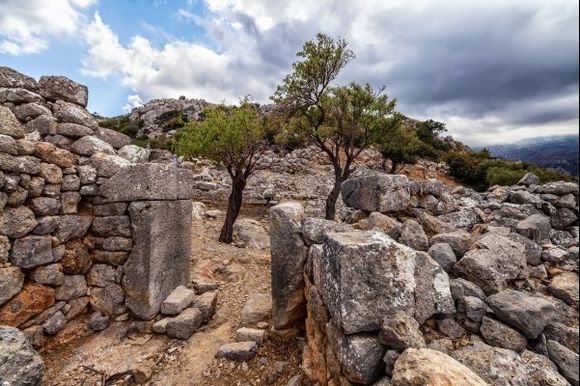Nestled between two hills, Lato’s geographical positioning not only provided a breathtaking overlook of Mirabella Bay but also a natural fortress against potential invaders. Named after the goddess Leto, revered in Doric dialect as Lato, the city-state was a beacon of prosperity and a pivotal member of the League of Cretan Cities. Despite its flourishing state, Lato found itself in frequent conflict with Olous, underscoring the competitive nature of ancient city-states.
Archaeological Revelations and Doric Legacy:
The concerted efforts of archaeologists F. Halbherr, L. Mariani, and A. Taramelli in the late 19th century led to the identification of the site as Ancient Lato. The subsequent French-led excavations between 1899 and 1901 unearthed the city’s intricate layout and architectural marvels, revealing the sophistication of its urban planning and the communal life of its inhabitants.
A Glimpse into Daily Life and Governance:
Ancient Lato’s urban fabric was woven around a twin acropolis, with residences featuring simple yet functional designs, including dual-room structures with central fireplaces. The ingenuity of water collection through subterranean cisterns highlights the adaptability and resourcefulness of its people. The journey to the Agora, ascending 80 steps, led to the heart of Lato’s civic life, where a column-less temple and numerous 6th-century B.C. figurines were discovered, offering insights into the religious practices and artistic expressions of the era.
The Prytaneion stood as a monumental symbol of governance, its theater-like structure accommodating the political and social gatherings of Lato’s elite. The central chamber, with its eternal fireplace, embodied the communal spirit and democratic ethos of the city-state.
Cultural and Architectural Splendors:
Beyond the realms of governance, Lato boasted significant cultural and religious edifices, including a grand temple and an open-air theater capable of hosting 350 spectators. These sites not only underscored the city’s cultural vibrancy but also its architectural prowess and the communal importance of performance and worship in Doric society.
Conclusion:
Our exploration of Lato was more than an archaeological excursion; it was a journey back in time to the heart of ancient Cretan civilization, where strategic ingenuity, communal living, and cultural richness flourished. Amidst the ruins of Lato, we found ourselves captivated by the stories of its people, their lives interwoven with the fabric of Doric heritage, echoing through the ages from the spectacular vantage of Mirabella Bay.
Sorry, no records were found. Please adjust your search criteria and try again.
Sorry, unable to load the Maps API.
